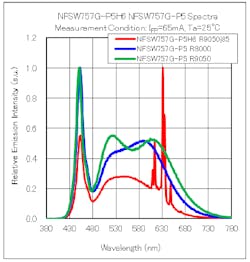Nichia has made an announcement focused on two separate packaged LED families that together will enable what the company calls Circadian Tune technology. The company has described a new LED concept that utilizes a traditional blue pump with a cyan phosphor formulation to deliver a spectral power distribution (SPD) that adds energy around the sensitivity peak of the circadian system. Nichia will pair that LED with TriGain-phosphor-based LEDs that deliver solid-state lighting (SSL) with high CRI and warm CCT yet with little or no efficacy penalty.
The announcement of the new TriGain-based components comes just a few weeks after Nichia and GE Current announced a license agreement focused on the TriGain technology developed originally within GE Lighting. At the time of that licensing announcement, GE Current revealed that Nichia had been making TriGain-based LEDs specifically for Current to use in general lighting products for many years. So it’s no surprise to hear Nichia announce commercial availability of TriGain LEDs.
And as speculated in our story a few weeks ago, the technology is initially available in Nichia’s workhorse 757 mid-power portfolio with components in a 3×3-mm footprint. Nichia calls the TriGain-based products Warm White TriGain. The model numbers are NFSW7757H-V1H6 and -V1H5. The H6 variants are 90-CRI emitters and the H5 80-CRI emitters. Nichia said it will extend TriGain technology into its chip-on-board (COB) LED portfolio in the near future.
Race to cyan
Moving to the cyan front, Nichia is yet another entrant in what is becoming a race in how best to deliver 480-nm-range spectra for the non-visual system. You will generally hear that spectral energy in the blue region can improve alertness in humans and possibly improve productivity. Moreover, blue exposure during the day is important in maintaining circadian entrainment and optimum sleep patterns, while blue energy at night can disrupt those patterns.
But it’s also known that not just any blue will do. Phosphor-converted white LEDs most often utilize a blue pump in the 450-nm range because manufacturing LEDs at that wavelength delivers maximum wall plug efficiency. But circadian researchers focused on the non-visual receptors have long known that the peak sensitivity for the intrinsically photosensitive retinal ganglion cells (ipRGCs) was more in the cyan region around 480–490 nm.
In any case, the interest in lighting for health and wellbeing has driven LED manufacturers to pursue different paths toward delivering spectral energy around 480 nm and making the SPD more uniform across the blue region. One approach used by Bridgelux and Samsung involves using dual emitters as a pump with one of the emitters in the cyan region. More recently, Lumileds has partnered with BIOS in developing a phosphor-converted white LED with a 490-nm pump.
Nichia believes that the technology it calls Phosphor Converted Cyan will ultimately enable better system-level efficacy than other approaches. The LEDs will feature the same forward voltage delivered by the TriGain LEDs with which it will be paired and also the same Z-height dimension for matched focal lengths that ensure uniform mixing.
“New Circadian Tune LED products are truly innovative. Through an optimization of efficacy, color quality and melanopsin stimulation, we can better target ipRGCs,” said Satoshi Okada, general lighting business planning manager at Nichia Japan. “Additionally, the utilization of a traditional 80-CRI warm white for the relaxing portion limits the color quality of the system. To overcome these limitations, Nichia has introduced this Phosphor Converted Cyan and Warm White TriGain pairing.”
Nearby, we have posted the SPD diagrams of the LED pair with circadian sensitivity denoted on the cyan LED SPD. As you can see, that SPD goes to effectively zero emission in the green region and thus it would have to be paired with a broad-spectrum LED to deliver white.
The one perplexing element to the concept is that both the cyan and TriGain LEDs deliver significant blue peaks at 455 nm, although that peak is relatively reduced in the TriGain component. Still, ultimately it seems like a mix of the cyan phosphor, some yellow-green phosphor, and TriGain phosphor on the same blue pump would be ideal. The blue peaks in two separate LEDs essentially represent wasted energy. Nichia would not comment on future plans, but we’d expect that such a single LED might emerge with cyan and TriGain phosphor as engineers overcome technology challenges.
For up-to-the-minute LED and SSL updates, why not follow us on Twitter? You’ll find curated content and commentary, as well as information on industry events, webcasts, and surveys on our LinkedIn Company Page and our Facebook page.







